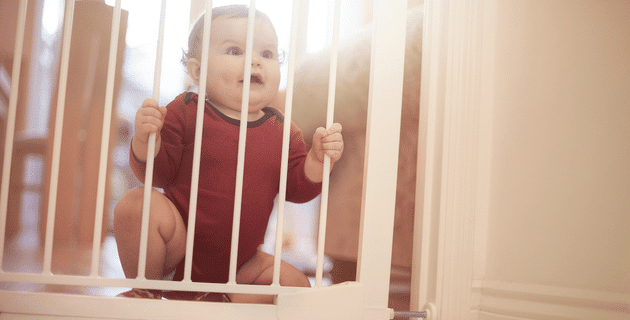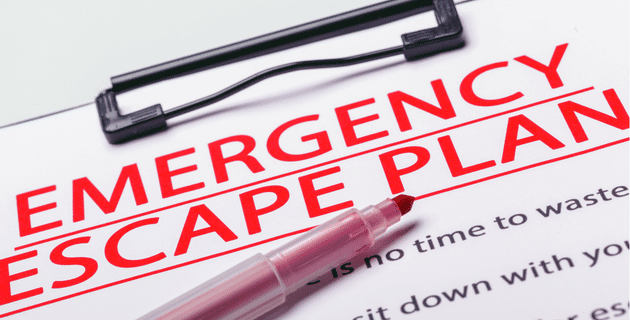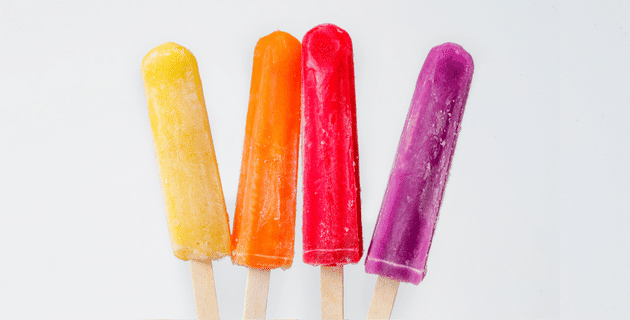
by California Casualty | Safety |
You’ve got a new addition to your family – or you’re expecting one soon. Congratulations! There is a lot to do to prepare, including getting your home ready for your new baby.
Here’s a checklist to help better prepare your home for your new little bundle of joy.
In the Bedroom
-
- Take strings off of the bottom of sleepers (clothing) so they don’t get wrapped around baby’s toes. Check all clothing for loose buttons that could be swallowed.
- Remove mobiles when the baby can sit on his or her own.
- Adjust the mattress so it’s in the lowest spot when the baby can pull up to a standing position.
- Store creams and smaller objects that your baby could fit in its mouth up high and out of reach.
- Place a protective cover on all unused outlets.
- Wind or wrap electric cords so that babies cannot pull on them, causing lamps or other appliances to fall.
- Wrap or tie up drapery cords so they are out of reach. Use cordless window blinds if possible.
- Make sure all heavy furniture, like drawers and desks, are anchored to the wall to prevent them from falling over.
In the Kitchen
-
- Make sure high chairs are sturdy and tray latches are secure.
- Install cabinet locks so when the baby starts exploring, little fingers won’t get into the contents.
- Install appliance locks so baby can’t pull open an oven or dishwasher door.
- Use a stove guard that attaches to the front and blocks knobs so that curious kids can’t turn them on.
- Store cleaning products out of reach of baby. Store them safely up high or behind a secured cabinet. Similarly, keep any alcohol out of reach.
- Keep all knives, cooking utensils, smaller appliances, and glassware safely stored away in cabinets or drawers.
- Consider a child safety look on pantry doors to keep curious kids away from unopened groceries.
In the Bathroom
-
- Set your water heater to 120 Fahrenheit or below to prevent burns. Or install an anti-scald device on your tub’s faucet.
- Use nonslip mats for the bathtub and any tile floors or hard surfaces.
- Put a rubber spout cover on the tub faucet to protect from bangs or bruises.
- Replace any bathroom trashcans that do not have lids.
- Make sure the toilet seat has a protective lock and that it is never left up for the baby to fall in.
- Store away fragrances, razors, soaps, styling tools, makeup, etc. out of reach.
In the Laundry Room
-
- Get a child safety lock for your washer and dryer doors so that curious toddlers cannot crawl inside. (Some newer models may include safety locks.)
- Store bleach and detergent pods out of reach. While they look good enough to eat, pods can be poisonous.
- Use a lock on the laundry room door to prevent curious crawlers from exploring, especially when machines are in use.
- Never leave hot irons or steamers plugged in.
More Throughout the Home
-
- Mount any heavy furniture to the wall so it doesn’t tip. If you can’t mount your television, secure it in a cabinet.
- Block staircases with a hardware-mounted baby gate to ensure it stays put. Pressure-fit gates may not. Know that safety gates are designed for children ages 6-24 months.
- Install window guards to prevent babies and toddlers from falling out of open windows.
- Add furniture padding to pointy corners on coffee tables, kitchen counters, and other places.
- Remember that toddlers will pull themselves up on furniture so ensure that it is secure.
- Install pinch guards to protect little fingers from getting pinched in doors.
- Cover any open outlets with child-safe covers.
- Keep chargers and any other cords stored away and out of reach.
- Make sure anything breakable, like decorative vases, glass photo frames, or indoor planters are placed safely out of reach.
- Make sure the doors on your fireplace remain closed and that you use a protective gate to keep the baby at a far enough distance away.
As a new parent who cares about safety, you’re going to be great. Enjoy your new arrival!
This article is furnished by California Casualty, providing auto and home insurance to educators, law enforcement officers, firefighters, and nurses. Get a quote at 1.866.704.8614 or www.calcas.com.

by California Casualty | Safety |
When disaster strikes, you may have only minutes to gather your loved ones, your pets, and your belongings, and get on the road. Are you ready?
Whether it’s a flood, fire, or other emergency, there are times when evacuations are necessary. These are often stressful times when you need to move quickly, and might not have time to grab everything you need. Preparing for emergency evacuations ahead of time will help you and your family know exactly what to do, and what to bring with you, in times of crisis.
Here’s what you need to consider when planning to evacuate.
Learn about local disasters and policies.
-
- Your place of work, your children’s school or daycare, and your local community probably have evacuation plans. You’ll want to find out about them, so that you can incorporate that information in your plan if it applies. Ask these places how they communicate about disaster procedures and what their policies are for emergencies and evacuations.
Pack it up.
-
- Pack an emergency kit full of essential items and documentation your family will need that’s ready to go and keep it in a place where you can grab it easily. Make sure it’s one you can carry or transport easily if you have to walk long distances or travel on public transportation in an emergency.
- Pro Tip: Revisit the content of your kit every six months. That’s when food may expire and children’s clothing sizes may change.
-
- You will need nonperishable food, bottled water, and supplies for 3 days. This includes soap, hand sanitizer, disinfecting wipes, and prescription medications. Make sure you include supplies for pets or infants, such as food and formula, and for any special dietary needs for members of your family. Also pack clothes and pajamas for every member of your family, as well as any bedding, pillows and sleeping bags. Finally, bring a first aid kit and all of your devices and chargers, as well as a battery-powered radio to stay on top of news and information.
-
- Keep a small amount of cash or traveler’s checks at home in a safe place where you can access them in case of evacuation. Store important papers in a fireproof, waterproof container that may be grabbed in case of an emergency. These may include birth certificates, marriage certificates, passports, insurance policies, wills and deeds, and even treasured photos.
Plan your escape route.
-
- Plan for the worst-case scenario. You want to make sure that every member of the family can exit your home safely in the event of an active disaster, such as a fire or earthquake.
-
- Draw a floorplan for your home. Use a blank sheet for each floor. Mark 2 escape routes from each room. Hang the drawing at eye level in each child’s room. Make sure children understand the drawings. Do a room tour and point out the exits. Practice using them. Talk about when your children might have to use them.
-
- Plan for which adults are bringing which items packed in the previous section. Dividing the responsibilities will help you get out more quickly.
Know where to go.
-
- Know your options about where you can evacuate. You may choose to evacuate to a shelter in your town, to a local hotel or motel, or to family or friends in another town, away from the danger. It also may depend on the type of disaster. You may not be able to stay local in a widespread flood but might be able to shelter in a hurricane. Download the FEMA App to locate emergency shelters in your area.
-
- If you choose the local shelter, find out the rules. You want to make sure that they can accommodate your family. You’ll also have to make separate arrangements for pets. (See the pet section below.)
-
- Choose destinations in different directions in case the emergency is in one part of town. Have the addresses and phone numbers handy for easy access.
Map it out.
-
- Keep a full tank of gas if evacuation seems necessary. Gas stations may have long lines or not be able to pump during a power outage.
-
- Be familiar with alternate routes in case you cannot take the route you know. Be alert for road hazards, washed-out bridges, and downed power lines. Avoid driving in flooded areas.
-
- Bring a physical map in case you don’t have access to a GPS or if satellites go down or your devices run out of power.
Plan for pets.
-
- You want to protect your pets during a disaster. That means you will need to find them a safe place to shelter, whether it’s with you at a pet-friendly location or at an animal boarding facility. Know that facility’s evacuation plan if they may be in the region.
-
- Pack pet food, leashes, litter boxes, crates, beds, toys, and any other supplies needed by your pet. Bring a copy of updated veterinary records.
-
- Make sure your pet is microchipped and has a proper ID on his or her collar if applicable. Bring a photo of you and your pet together, which can help if for any reason your pet gets separated from you.
Stay in touch.
-
- Establish a place to meet near your home in case you get separated. Choose a place immediately outside (such as the driveway), a little bit further (such as the stop sign at the end of the street), and a location even further (such as the neighborhood grocery store).
-
- Choose an out-of-state contact that you all can call if needed. Update that person when you are evacuating and as you change locations.
Ready, set, go.
Take the 10-minute evacuation challenge. See if you can get your family and belongings in a car in just 10 minutes. Then, practice your evacuation drill regularly.
Finally, check that you have enough insurance to cover your home, car, and possessions in case they are destroyed in a natural disaster or other emergency. You’ll all have peace of mind knowing that you are fully prepared and know exactly what to do.
This article is furnished by California Casualty, providing auto and home insurance to educators, law enforcement officers, firefighters, and nurses. Get a quote at 1.866.704.8614 or www.calcas.com.

by California Casualty | Auto Insurance Info, Safety |
You’ve got the captain’s hat. You’re bringing the cooler. But what else do you need—or want—to have fun and stay safe on the water this summer?
There are literally hundreds of great boat accessories on the market, plus lots of safety gear to choose from. We’ve compiled a list of practical and fun items you’ll want to keep on your boat this summer. Scroll down for a list of what to leave at home, too.
First the fun…
A mounted grill – Treat everyone to a BBQ out on the open water. You can find boat grills in gas, charcoal, and electric. Just make sure to wait to grill until the boat has stopped, and don’t leave it unattended.
An inflatable boat slide – Everyone loves a boat slide! Choose one that inflates quickly, stores compactly, and holds adults as well as children. Durability is a plus.
Tow tubes – Give your passengers a ride on the waves using a tow tube. These fun accessories come in different shapes and sizes and accommodate a range of ages. Make sure you check the maximum weight and rider limit and equip all of your riders with life jackets.
Speakers – Crank up the tunes with some great speakers that are waterproof and can stand up to the elements, including wind, sun, and the motion of your boat.
Fish finder – Take the guesswork out of fishing. Today’s fish finders feature digital screens and include systems like GPS, electronic compasses, and radar. Starting at about $100, these instruments can go into the $1,000s.
Then the practical…
10-in-1 Boat Tool – This is the “Swiss Army Knife” of boat tools with every gadget imaginable. Not only does it include a fishing line cutter, a marine gas cap key, and a safety whistle, it includes a beer and wine bottle opener.
Telescopic boat hook – Until you have one, you don’t realize how useful these are! These hooks help you retrieve items that fall in the water. They also help you more easily get hold of the dock lines attached to pilings.
Underwater LED lights – If you take your boat out at night, an underwater light can help your boat be seen in the dark. These lights can come in different colors and add a cool ambiance.
Non-tipping can cooler – The rocking motion of your boat can easily tip your drinks. Secure them, and keep them cold, in a non-tipping can cooler.
Boat fenders – These cushions absorb the impact of bumps against docks and other boats.
And the necessities…
Don’t forget to pack a boat emergency kit full of the boat safety basics:
-
- Life jackets and throwable personal flotation devices in case someone goes overboard
- Fire extinguishers (check the regulations to see how many you need for the size of your boat)
- First aid kit, including motion sickness remedies
- VHF Radio for communications
- Signal flares (both visual and sound)
- Waterproof flashlight
- A way to get weather updates
- Basic tool kit for repairs and basic maintenance
Remember to leave these at home…
-
- Spray sunscreen which can leave a slippery film on deck
- Shoes with dark soles that leave marks
- Cigarettes/cigars that can accidentally cause a fire
- Perfume that attracts bees and can cause nausea in close quarters
- Glass containers that could shatter
- Plastic grocery bags that could fly off the boat and clog waterways
Finally, check your boat insurance. Make sure you’re fully protected from accidents, uninsured boaters, and liability claims.
Happy boating!
This article is furnished by California Casualty, providing auto and home insurance to educators, law enforcement officers, firefighters, and nurses. Get a quote at 1.866.704.8614 or www.calcas.com.

by California Casualty | Safety |
Summertime is a great time to be outside and enjoy the sunshine. But sometimes the summer heat can be too much. When it’s hot and humid, like most summer days, it’s easy for us to get overheated, which in turn can lead to serious heat-related illness.
High temperatures are especially dangerous for the elderly, pets, and young kids. So, if you’re sending the kids out to play, or if you’re planning to be outdoors enjoying summer fun for an extended period of time, watch for signs of overheating and follow these tips to cool down quickly.
1. Drink cool liquids.
The more water you drink, the better your body is able to regulate heat by sweating. Even better than water – especially if you’re starting to overheat – is coconut water. It has additional vitamins, minerals, and electrolytes. Also, try cold peppermint tea. Peppermint has a natural cooling effect. Put a peppermint tea bag into a glass filled with ice water, stir and drink.
Note: By the time you feel thirsty, you most likely are dehydrated. Try to drink water on a regular basis to stay hydrated.
2. Eat a frozen summer snack.
Who doesn’t love a popsicle on a hot summer day? These treats do double duty; they’re delicious and they help to cool you down. Frozen smoothies also are a yummy alternative, or try frozen fruit like watermelon wedges. You can even make your own ice cube popsicles with fruit and fruit juice.
3. Apply ice to parts of your body.
If you’re feeling hot or ill from the heat, ice can help. Take an ice pack, or an ice cube wrapped in a covering, and apply it to parts of your body. Look for places where your veins are closest to the surface; that will help cool you the quickest. Try the insides of your wrist, your neck, chest, and temples.
4. Find cool water.
Take a dip in the pool or lake. Run through the sprinklers. Get sprayed by the hose. Put your wrists under cold running water. Take a room-temperature bath. All of this will help to cool down your body. You can also soak two washcloths in cold water. Wring them out; put one around your neck and the other on top of the inside of your wrists.
5. Make your own cooling spray.
Fill a spray bottle with one part aloe vera gel and three parts cold water. Shake it up and you have a cooling body spray.
Pro tip: Keep the cooling spray in a chilled metal bottle to keep it cooler longer.
6. Create a cross breeze.
Place a fan across the room from a window. The breeze coming in will be caught up by the fan and circulated. Set up more fans around the room for an even greater cooling effect.
7. Eat spicy foods.
It may seem counterintuitive, but eating spicy foods can cool you down. That’s because spicy foods increase your blood circulation and help you sweat. Sweat in turn cools you down. So, enjoy that kick of spicy summer salsa!
8. Get out of the heat.
Get to a shady area, or better yet, inside to the air conditioning. Then, use one of the other techniques listed above to help cool down. Call for medical help if needed. See below for guidance.
9. Protect your pets.
Our pets get hot too, especially our fur babies. If your pet is going to be out in the sun with you,
follow our heat safety tips for pets.
Know the signs of overheating
There are 3 stages of overheating, each progressively more dangerous than the previous one. according to the CDC. Stages 1 and 2 are usually able to be managed at home. Stage 3 requires medical attention.
- Stage 1 (Heat Cramps): You may feel tired, dizzy, and dehydrated, and your muscles may cramp.
What to do: Rest and rehydrate. Drink water or something with electrolytes. Massage the affected muscles and wait for the cramps to go away.
- Stage 2 (Heat Exhaustion): Headaches, nausea, vomiting, and heavy sweating are symptoms of heat exhaustion.
What to do: Move to a cool place. Stop all activity and drink water or something with electrolytes. If the symptoms last for more than an hour, seek medical help.
- Stage 3 (Heat Stroke): You will stop sweating, even though you feel extremely hot. You may feel confused. You could breathe fast. You might have a seizure.
What to do: Heat stroke can cause permanent brain damage or even death.
Go to the hospital immediately.
Stay safe and have a fun summer!
This article is furnished by California Casualty, providing auto and home insurance to educators, law enforcement officers, firefighters, and nurses. Get a quote at 1.866.704.8614 or www.calcas.com.

by California Casualty | Auto Insurance Info, Homeowners Insurance Info, Safety |
Summertime was made for fun-from beach vacations to family barbecues, road trips, and dips in the pool. But unfortunately, sometimes during all that fun, there’s a mishap or two….
Make sure that your home and property are fully protected in case anything happens. Use this guide as a reference on how to insure yourself and your family for summer fun.
Swimming Pools
Your swimming pool is probably covered under your homeowner’s policy. That being said, you’ll want to make sure that you have enough to cover the following situations.
If someone is hurt or drowns in your pool, you are responsible. It doesn’t matter whether or not you gave them permission to swim. Your personal liability coverage is designed to cover these instances. Typical homeowner’s policies carry $100,000 of liability protection. If you have a swimming pool, you need considerably more. Experts suggest either increasing your personal liability (with the maximum being $500,000 or $1,000,000 depending upon the state) or adding a personal umbrella policy. Umbrella policies start at $1,000,000 in coverage. In addition, take steps to prevent these tragedies by securing your pool with a fence and self-latching gates. Make sure children never swim unattended. Install alarms that alert you if someone is entering the water.
Pro Tip: Make sure your pool meets the local municipal code. We’ve seen some insurance companies refuse to pay if the pool is not up to code.
- Tree falls into your pool
Summer storms can be intense, and could cause your tree to fall on your house or into your in-ground pool. If a tree falls into your pool, your homeowner’s insurance could cover a reasonable expense to remove it if it was felled by a covered peril and if it struck a covered structure (like your pool) and damaged it. No more than $500 will be paid for any one tree and no more than $1,000 total for any one claim.
Trampolines and Swing Sets
Trampolines and swing sets are considered attractive nuisances, places on your property that can attract children but also put them in danger. (Swimming pools are, too.) You will need to safeguard them, such as by making sure they are in a fenced area.
Trampoline injuries or deaths are covered under your personal liability insurance as part of your homeowner’s policy. Check with your insurance agent to see if you have enough coverage for a trampoline accident. Also, check to see whether there are any individual limits to that coverage. Protect against these accidents by installing an enclosure to secure the trampoline so there are no unsupervised guests. Always supervise children while they are using the trampoline and enforce the rule that only one person uses it at a time.
Swing set accidents also are covered by personal liability. Make sure your homeowner’s policy has adequate coverage. Supervise children whenever they are using the swing set. Inspect your set regularly and cover sharp corners or protruding nails that could cause injury. Check that there is a minimum of 22 inches between swings and that the slide is no longer than 10 feet. Also, make sure there’s at least 10 feet of clearance around the swing set.
Dog Bites
Dogs spend time outside with us in the summer. Sometimes that can lead to circumstances where dogs can bite. If your dog bites a third party, you are responsible. Liability coverage protects you in this instance. It pays for the bite victim’s medical expenses and covers your legal fees if they sue you.
-
- Make sure that your dog’s breed is not restricted by your insurance policy. Some policies will not cover breeds such as Pit Bulls, Doberman Pinschers, or Rottweilers. California Casualty does not currently have such restrictions.
-
- If your dog is a victim of a bite, pet insurance can help cover that emergency vet visit. You also may be able to be reimbursed by the other dog owner’s liability coverage.
BBQ Grill Fires
Backyard barbecues are a favorite summertime activity. We may not think about them being dangerous, but they can be. Practice summertime fire safety. Keep your grill away from the house and any other structures. Store your charcoal or propane safely and away from the heat. Keep a fire extinguisher handy. Always supervise young children when around a grill.
-
- If a grill fire spreads to your home or property, and causes costly damage, your homeowner’s policy will likely cover repairs, minus the deductible.
-
- If a guest is injured by a fire on your property, and you are legally responsible for that bodily injury, your liability insurance will cover that person’s medical expenses. If you are not liable, but your guest was injured through his/her own fault, then Coverage F – Medical Payment to Others may cover your guest’s medical bills.
Boats and Personal Water Craft
Small boats like kayaks and canoes may be covered under your homeowner’s policy as personal property. If you have a boat, you will need a separate boat insurance policy. You also need one for personal watercraft such as jet skis.
- Boats – The costs of insurance will vary depending on the value of your boat and where you keep it. For a California Casualty property contract, the policy will cover up to $1,500 for boats and a trailer for 16 named perils but not for theft away from the residence.
- If you’re transporting your boat on a car trailer, your auto insurance will likely cover any accidents.
o If you are at fault for a car accident, your auto liability will extend coverage but there will be no physical damage coverage for the boat or trailer.
- If you want physical damage coverage for the trailer, it needs to be added to the auto policy. If you want physical damage coverage for the boat, it needs to be included on the boat policy.
- If your boat is parked at your house and is damaged, your homeowner’s insurance may cover it. Otherwise, your boat policy will cover accidents on the water.
- Personal Watercraft – Your jet ski or other personal watercraft will need its own policy to protect you from vandalism, accidents, and liability for injuries to people riding your personal watercraft. This type of policy is available through the Agency Services division of California Casualty.
Rental Car Accidents
If you’re heading on vacation this summer, you might be driving a rental car. Your own auto insurance may cover a rental car, minus your deductible, or the credit card that you used to book the car may come with insurance. If not, you will want to make sure that you are covered by purchasing rental insurance through the rental car company. Here’s what you will need to think about.
- Collision Damage or Loss Damage Waiver – Optional in many states, this type of coverage pays for the rental car if it is damaged or stolen. There usually is a deductible, for which you’re responsible. If your auto policy covers collision damage, make sure that it also covers “loss of use.” For a rental company, getting a car repaired in the shop means it loses the income it could be getting from renting the car. The rental company can charge you the daily rental rate for each day the vehicle is out of service.
- Personal Accident Insurance – This optional policy covers you, the driver, in the event of an accident, including ambulance transportation and medical bills.
- Supplemental/Additional Liability Insurance – This optional policy covers the other driver and passengers whom you may injure in an accident. It also covers any property damage. You likely have liability on your own auto policy. Check to make sure the liability limit is enough. You can purchase supplemental liability insurance with the rental car company or get an umbrella policy from your current insurer.
- Personal Effects Coverage – This optional policy covers your possessions if they are damaged, lost, or stolen, something your homeowner or renter’s policy may already cover.
Have a great, fun-filled summer!
This article is furnished by California Casualty, providing auto and home insurance to educators, law enforcement officers, firefighters, and nurses. Get a quote at 1.866.704.8614 or www.calcas.com.

by California Casualty | Homeowners Insurance Info, Safety |
School’s out, which means if your child is old enough, he or she may find themselves home alone without you. Navigating the house on their own, or with a babysitter, can definitely help kids build independence. However, you also want to make sure they’re safe.
For those times when your child may be home alone or with a babysitter, here’s a list of important summer safety tips.
Lesson 1: Basic First Aid
Decide what first aid your child may be capable of providing. If he or she gets a small cut or scrape, for example, your child can clean the wound and put on a band-aid.
What You Can Do: Prepare a first aid kit with those supplies that you would like him/her to use for such things as minor cuts, scrapes, and burns. Go over the items in the first aid kit and show your child how to use them. Then have your child role-play and practice with them. Discuss when they might need to call for help if the injury seems more serious than they can treat with the kit.
Pro Tip: If your child has a smartphone or device and is allowed to use it, download the Red Cross First Aid App.
Fire safety at home is important. Fires can be scary but even the sound of the smoke alarm can be frightening.
What You Can Do: Let your child hear the sound so they know what to expect. Then discuss the fact that they need to leave the house and contact a trusted adult such as a neighbor or someone by phone. If there’s an active fire that they see, they can call 9-1-1. Since your child can be anywhere in the house when the smoke alarm goes off, practice how to leave each room. Remember the rule of 2/2/2. Practice two ways out of every room, two times of the day (day and night) at least two times a year.
Lesson 3: Emergency Contact List
Help is just a phone call away. Share the emergency list with your child.
What You Can Do: Post the list of parents’ work and cell numbers, family, and friends who will be available to your child as needed. Include neighbors who can be a nearby onsite resource. The list also should include 9-1-1 for big emergencies (and your house address should the dispatcher need it). However, explain to your child the types of situations that would necessitate dialing 9-1-1.
Pro Tip: Involve your family member or neighbor and have your child give them a quick call to ask if it’s okay to put their names on your call list. That will give your child practice making the call.
Lesson 4: Bad Weather or Emergency Situations
Even in the summer, bad weather can strike. If your child is at home alone or with a sitter and there is a severe storm or another emergency situation, make sure they know what to do.
What You Can Do: Make sure your child or sitter knows how to check the weather, on their phone or your local weather channel, and have them sign up for emergency alerts. Also, make sure they know where you keep your emergency kit if they need to take shelter. Go over the family disaster plan with them so they know exactly who to call and where to go. It’s important to discuss emergency scenarios with your child and sitter before you leave them alone, so they won’t panic and will know exactly what to do.
Lesson 5: Home-Alone Rules
Depending upon your child’s age and maturity, and your own comfort level, set rules for when they are home alone or with a sitter.
What You Can Do: Go over the rules with your child. Practice them and explain their importance. And then write them down as a reference, that they can look at. Here are some rules you may consider.
Limit cooking and stay away from fire sources.
Decide if your child will be allowed to use the stove, microwave, or toaster. If not, make sure there are plenty of cold meal options and snacks. If you do allow cooking of any kind, review the safety rules. Make sure your child knows what materials are dangerous for the microwave, and not to fish out a stuck piece of toast from the toaster with a metal fork. Decide on the rules for knives. Make sure your child doesn’t do anything alone that he or she hasn’t already done successfully under your supervision. Finally, ensure that your child knows where the fire extinguisher is and how to use it in the event of a kitchen fire. (Also, if this happens, your child should call an adult and 9-1-1.)
Keep the house locked and don’t let strangers know you are alone.
Make sure all doors and windows are locked when your child is home alone or with a sitter. If there is a security system that will be set, teach your child how to enable and disable it. Let your son or daughter know not to answer the door, even for delivery people. If someone calls and asks for you, provide a script of what to say; for example, “he or she is busy right now. Can I take a message?” Write that by the phone so your child doesn’t have to remember it. Be clear on whether your child is allowed to leave the house, and under what circumstances. If he or she does leave for any reason, instruct your child to tell you. You should always know where your child is.
Set rules for the phone, computer, smart devices, and TV.
Screen time is a big draw to kids home alone. Set the rules so they know what is allowed and what is not. You may allow gaming but not social media, or a movie marathon but not long text conversations. Make sure your child does not share that they are home alone, whether on social media, text or other interactions.
Specify the way your child will check-in.
You will want reassurance that your child is all right. Ask him or her to check in with you at specified times and in specific ways. Decide whether a text or call will suffice and how often. Make it a rule that they have to answer you right away if you call.
If your child is new to being left alone, start small. Leave for a short errand. Praise your child for following the rules. Continue to model safety practices, and before long, you’ll be surprised at how responsible your child can be when home alone.
This article is furnished by California Casualty, providing auto and home insurance to educators, law enforcement officers, firefighters, and nurses. Get a quote at 1.866.704.8614 or www.calcas.com.






